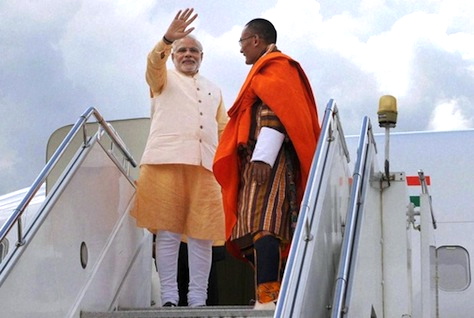It’s been just over a month since the historic election that vaulted Narendra Modi to the top of India’s government, and he took office on May 26, nearly four weeks ago.![]()
So how has his tenure as India’s prime minister gone so far?
Fairly smoothly, though of course it’s still far too soon to tell just whether Modi (pictured above with Bhutanese prime minister Tshering Tobgay), ushering in a new government with the slogan of ‘minimum government, maximum governance,’ can achieve the transformational economic and other policy achievements.
With his first day in office, Modi made global headlines by inviting Pakistani prime minister Nawaz Sharif to attend his swearing-in ceremony, which saw the two regional leaders hold closed-door discussions on Modi’s second day in office.
On June 1, his government marked the relative seamless creation of the new state of Telangana, out of what was formerly a much larger Andhra Pradesh, and the rise of its first chief minister Kalvakuntla Chandrashekar Rao (known as ‘KCR’), though KCR is already making headlines for his blunt approach to press freedom.
Modi has already started to outline his economic policy priorities, which will kick off with a concerted effort to lower inflation. His government will unveil its first federal budget in July, but for now, Modi has signalled that he’s willing to deliver tough policy to improve fiscal discipline that will almost certain including cuts to fuel subsidies and further liberalization of India’s economy, especially with respect to foreign investment. That was clear enough from Indian president Pranab Mukherjee’s address to the Indian parliament earlier this week.
Modi has also appointed a strong, streamlined cabinet that was met with approval among both domestic and global observers:
- Rajnath Singh, home minister, largely in reward for his largely successful role serving as the president of the Bharatiya Janata Party (the BJP, भारतीय जनता पार्टी) through the election campaign and as a vital conduit between old-guard BJP leaders and Team Modi.
- Sushma Swaraj, external affairs minister, will become the most senior female minister in the Modi government, and as India’s equivalent of foreign minister, she’s the highest-ranking ‘outsider’ in the Modi cabinet, with links to much of the old-guard leadership that Modi sidelined on his way to the premiership.
- Arun Jaitley is possibly the most important minister in government, leading a consolidated portfolio of finance, corporate affairs and defense. Jaitley, a former law and justice minister in prior BJP governments, and formerly elder of the opposition in the Rajya Sabha, the upper house of India’s parliament, was widely expected to serve as finance minister, despite losing his election in Amritsar constituency in Punjab state.
- Nitin Gadkari, a former BJP party president, will play an important role in guiding India’s future infrastructure leading a combined portfolio that includes roads, highways and shipping. He’ll have a chance to do for the entire county what he did as public works minister in Maharashtra state.
- DV Sadananda Gowda, the former chief minister of Karnataka state, will work closely with Gadkari as railways minister.
- Venkaiah Naidu, a former BJP party president in the early 2000s, is the minister for urban development, housing and urban poverty alleviation.
- Ravi Shankar Prasad, an attorney, and formerly the deputy opposition leader of the Rajya Sabha, is law and justice minister.
- Maneka Gandhi, the widow of Sanjay Gandhi and the daughter-in-law of the late Indira Gandhi, and the most high-profile BJP official within the Nehru-Gandhi family, serves as the minister for women and child development, in a tweak to the current leadership of the Indian National Congress (Congress, भारतीय राष्ट्रीय कांग्रेस), Sonia Gandhi and Rahul Gandhi.
Modi finished his first trip abroad as prime minister earlier this week, to neighboring Bhutan, where he addressed the country’s parliament and reaffirmed India’s ties with the Himalayan nation that’s only very recently turned to democracy — Bhutan experienced its first post-election transfer of power last July, and it went as peacefully as you might expect in an established democracy.
Bhutan, which is strategically nestled between China and India, has sometimes ruffled Indian leaders in the past over its growing ties with China. Its current prime minister, Tshering Tobgay, largely won election last year after Bhutanese voters felt the prior government had alienated New Delhi. Beginning with the 1949 treaty of friendship, India’s first prime minister Jawaharlal Nehru assumed control of Bhutanese foreign relations. Though a renegotiated treaty of friendship in 2007 contemplated a truly autonomous Bhutanese foreign policy, steps by Bhutan’s first democratically elected prime minister, Jigme Thinley, to create greater economic and political ties with China were met with scorn by India’s government in recent years.
Modi’s address to the Bhutanese parliament didn’t exactly welcome greater Bhutanese independence on foreign policy. But it was still effective in resetting and reaffirming Indo-Bhutanese relations after the turbulence of the Thinley era.
Photo credit to PTI.
